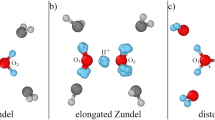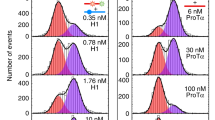Abstract
The solution structure of the first protein–protein complex of the bacterial phosphoenolpyruvate: sugar phosphotransferase system between the N–terminal domain of enzyme I (EIN) and the histidine–containing phosphocarrier protein HPr has been determined by NMR spectroscopy, including the use of residual dipolar couplings that provide long–range structural information. The complex between EIN and HPr is a classical example of surface complementarity, involving an essentially all helical interface, comprising helices 2, 2', 3 and 4 of the α–subdomain of EIN and helices 1 and 2 of HPr, that requires virtually no changes in conformation of the components relative to that in their respective free states. The specificity of the complex is dependent on the correct placement of both van der Waals and electrostatic contacts. The transition state can be formed with minimal changes in overall conformation, and is stabilized in favor of phosphorylated HPr, thereby accounting for the directionality of phosphoryl transfer.
This is a preview of subscription content, access via your institution
Access options
Subscribe to this journal
Receive 12 print issues and online access
$189.00 per year
only $15.75 per issue
Buy this article
- Purchase on Springer Link
- Instant access to full article PDF
Prices may be subject to local taxes which are calculated during checkout





Similar content being viewed by others
References
Postma, P.W., Lengeler, J.W. & Jacobson, G.R. Phosphoenolpyruvate:carbohydrate phosphotransferase systems. In Escherichia coli and Salmonella: Cellular and Molecular Biology (ed. Neidhardt F.C.) 1149–1174 (ASM Press, Washington DC; 1996).
Herzberg, O & Klevit R. Unraveling a bacterial hexose transport pathway. Curr. Opin. Struct. Biol. 4, 814–822 (1994).
Licalsi, C., Crocenzi, T.S., Freire, E. & Roseman, S. Sugar transport by the bacterial phosphotransferase system: structural and thermodynamic domains of Enzyme I of Salmonella typhimurium. J. Biol. Chem. 266, 19519–19527 (1991).
Lee, B.R., Lecchi, P., Pannell, L., Jaffe, H. & Peterkofsky, A. Identification of the N–terminal domain of Enzyme I of the Escherichia coli phosphoenolpyruvate:sugar phosphotransfease system produced by proteolytic digestion. Arch. Biochem. Biophys. 312, 121–124 ( 1994).
Seok, Y.–J., Lee, B.R., Zhu, P.–P. & Peterkofsky, A. Importance of the carboxyl terminal domain of Enzyme I of the Escherichia coli phosphoenolpyruvate:sugar phosphotransferase system for phosphoryl donor specificity. Proc. Natl. Acad. Sci. USA 93, 347–351 (1996).
Chauvin, F., Fomenkov, A., Johnson, C.R. & Roseman, S. The N–terminal domain of Escherichia coli enzyme I of the phosphoenolpyruvate/glycose phosphotransferase system: molecular cloning and characterization. Proc. Natl. Acad. Sci. USA 93, 7028– 7031 (1996).
Liao, D.–I. et al. The first step in sugar transport: crystal structure of the amino terminal domain of enzyme I of the E coli PEP:sugar phosphotransferase system and a model of the phosphotransfer complex with HPr. Structure 4, 861–872 ( 1996).
Garrett, D.S. et al. Solution structure of the 30 kDa N–terminal domain of Enzyme I of the Escherichia coli phosphoenolpyruvate:sugar phosphotransferase system by multidimensional NMR. Biochemistry 36, 2517–2530 (1997).
Wittekind, M. et al. Solution structure of the phosphocarrier protein HPr from Bacillus subtilis by two–dimensional NMR spectroscopy. Prot. Sci. 1, 1363–1376 ( 1992).
Herzberg, O. et al. Structure of the histidine–containing phosphocarrier protein HPr from Bacillus subtilis at 2.0 Å resolution. Proc. Natl. Acad. Sci. USA 89, 2499– 2503 (1992).
Kalbitzer, H.R. & Henstenberg, W. The solution structure of the histidine–containing protein (HPr) from Staphylococcus aureus as determined by two–dimensional 1H–NMR spectroscopy. Eur. J. Biochem. 216, 205– 214 (1993).
Jia, Z., Quail, J.W., Waygood, E.B. & Delbaere, L.T. The 2.0 Å resolution structure of the Escherichia coli histidine–containing phosphocarrier protein HPr: a redetermination. J. Biol. Chem. 268, 22490–22501 (1993).
van Nuland, N.A. et al. The high–resolution structure of the histidine–containing phosphocarrier protein HPr from Escherichia coli determined by restrained molecular dynamics from nuclear magnetic resonance nuclear Overhauser effect data. J. Mol. Biol. 237, 544– 559 (1994).
van Nuland, N.A.J., Boelens, R., Scheek, R.M. & Robillard, G.T. High–resolution structure of the phosphorylated form of the histidine–containing phosphocarrier protein HPr from Escherichia coli determined by restrained molecular dynamics from NMR–NOE data. J. Mol. Biol. 246, 180–193 (1995).
Jones, B.E., Rajgopal, P. & Klevit, R.E. Phosphorylation on histidine is accompanied by localized structural changes in phosphocarrier protein HPr from Bacillus subtilis . Prot. Sci. 6, 2107– 2119 (1997).
Liao, D.–I. et al. Structure of the IIA domain of the glucose permease of Bacillus subtilis at 2.2 Å resolution. Biochemistry 30, 9583–9594 (1991).
Worthylake, D. et al. Three–dimensional structure of the Escherichia coli phosphocarrier protein IIIglc. Proc. Natl. Acad. Sci. USA 88, 10382–10386 (1991).
Fairbrother, W.J., Gippert, G.P., Reizer, J., Saier, M.H. & Wright, P.E. Low resolution structure of Bacillus subtilis glucose pemease IIA derived from heteronuclear three–dimensional NMR spectroscopy. FEBS Lett. 296, 148– 152 (1992).
Hurley, J.H. et al. Structure of the regulatory complex of Escherichia coli IIIglc with glycerol kinase. Science 259, 673–677 (1993).
Huang, K., Kapadia, G., Zhu, P.–P., Peterkofsky, A. & Herzberg, O. A promiscuous binding surface: crystal structure of the IIA domain of the glucose–specific permease from Mycoplasma capricolum. Structure 6, 697–710 (1998).
Garrett, D.S., Seok,Y.–J., Peterkoksky, A., Clore, G.M. & Gronenborn, A.M. Identification by NMR of the binding surface for the histidine–containing phosphocarrier protein HPr on the N–terminal domain of Enzyme I of the Escherichia coli phosphotransferase system. Biochemistry 36, 4393–4398 (1997).
Clore, G.M., Gronenborn, A.M., Szabo, A. & Tjandra, N. Determining the magnitude of the fully asymmetric diffusion tensor from heteronuclear relaxation data in the absence of structural information. J. Am. Chem. Soc. 120, 4889–4890 (1998).
Clore, G.M. & Gronenborn, A.M. Determining structures of large proteins and protein complexes by NMR. Trends Biotech. 16, 22–34 (1998).
Nilges, M., Gronenborn, A.M., Brünger, A.T. & Clore, G.M. Determination of three–dimensional structures of proteins by simulated annealing with interproton distance restraints: application to crambin, potato carboxypeptidase inhibitor and barley serine proteinase inhibitor 2. Prot. Engng. 2, 27–38 ( 1988).
Clore, G.M., Starich, M.R. & Gronenborn, A.M. Measurement of residual dipolar couplings of macromolecules aligned in the nematic phase of a colloidal suspension of rod–shaped viruses. J. Am. Chem. Soc. 120, 10571– 10572.
Tjandra, N., Omichinski, J.G., Gronenborn, A.M., Clore, G.M. & Bax, A. Use of dipolar 1H–15N and 1H–13C couplings in the structure determination of magnetically oriented macromolecules in solution. Nature Struct. Biol. 4, 732– 738 (1997).
Omichinski, J.G., Pedone, P.V., Felsenfeld, G., Gronenborn, A.M. & Clore, G.M. The solution structure of a specific GAGA factor–DNA complex reveals a modular binding mode. Nature Struct. Biol. 4, 122–132 (1997).
Reizer, J. et al. Mechanistic and physiological consequences of HPr (ser) phosphorylation on the activities of the phosphoenolpyruvate:sugar phosphotransferase system in Gram–positive bacteria: studies with site–specific mutants of HPr. EMBO J. 8, 2111– 2120 (1989).
Napper, S. et al. Mutation of Serine–46 to aspartate in the histidine–containing protein of Escherichia coli mimics the inactivation by phosphorylation of Serine–46 in HPrs from gram–positive bacteria. Biochemistry 35, 11260–11267 ( 1996).
Weigel, N., Kukuruzinska, M.A., Nakazawa, A., Waygood, E.B. & Roseman, S. Sugar transport by the bacterial phosphotransferase system: phosphoryl transfer reactions catalyzed by Enzyme I of Salmonella typhimurium. J. Biol. Chem. 257, 14477–14491 (1982).
Garrett, D.S., Seok, Y.–J., Peterkofsky, A., Clore, G.M. & Gronenborn, A.M. Tautomeric state and pK a of the phosphorylated active site histidine in the N–terminal domain of Enzyme I of the Escherichia coli phosphoenolpyruvate:sugar phosphotransferase system. Prot. Sci. 7, 789–793 (1998).
Weigel, N., Powers, D.A. & Roseman, S. Sugar transport by the bacterial phosphotransferase system: primary structure and active site of a general phosphocarrier (HPr) from Salmonella typhimurium. J. Biol. Chem. 257, 14499–14509 (1982).
Begley, G.S., Hansen, D.E., Jacobson, G.R. & Knowles, J.R. Stereochemical course of the reactions catalyzed by the bacterial phosphoenolpyruvate:glucose phosphotransferase system. Biochemistry 21, 5552–5556.
Herzberg, O. An atomic model for protein–protein phosphoryl group transfer. J. Biol. Chem. 267, 24819–24823 (1992).
Andersen, J.W., Pullen, J.K., Georges, F., Klevit, R.E. & Waygood, R.E. The involvement of the arginine 17 residue in the active site of the histidine–containing protein, HPr, of the phosphoenolpyruvate:sugar phosphotransferase system of Escherichia coli. J. Biol. Chem. 268, 12325– 12333 (1993).
Nosworthy, N.J. et al. Phosphorylation destabilizes the amino–terminal domain of Enzyme I of the Escherichia coli phosphoenolpyruvate:sugar phosphotransferase system. Biochemistry 37, 65718–6726 (1998).
Reizer, J., Sutrina, S.L., Wu, L.–F., Deutscher, J., Reddy, P. & Saier, M.H. Functional interactions between proteins of the phosphoenolpyruvate:sugar phosphotransferase systems of Bacillus subtilis and Escherichia coli. J. Biol. Chem. 267, 9158– 9169 (1992).
Zhu, P.–P., Reizer, J. & Peterkofsky, A. Unique dicistronic operon (ptsI–crr) in Mycoplasma capricolum encoding Enzyme I and the glucose–specific Enzyme IIA of the phosphoenolpyruvate: sugar phosphotransferase system: cloning, sequencing, promoter analysis, and protein characterization. Prot. Sci. 3, 2115–2128 ( 1994).
Zhu, P.–P., Reizer, J., Reizer, A. & Peterkofsky, A. Unique monocistronic operon (ptsH) in Mycoplasma capricolum encoding the phosphocarrier protein (HPr) of the phosphoenolpyruvate: sugar phosphotransferase system. J. Biol. Chem. 268, 26531– 26540 (1993).
Ottiger, M., Delaglio, F. & Bax, A. Measurement of J and dipolar couplings from simplified two–dimensional NMR spectra. J. Magn. Reson. 131, 173–178 (1998).
Clore, G.M., Gronenborn, A.M. & Bax, A. A robust method for determining the magnitude of the fully asymmetric alignment tensor of oriented macromolecules in the absence of structural information. J. Magn. Reson. 133, 216–221 (1998).
Clore, G.M. & Gronenborn, A.M. New methods of structure refinement for macromolecular structure determination by NMR. Proc. Natl. Acad. Sci. USA 95, 5891–5898 (1998).
Brünger, A.T. et al. Crystallography and NMR system (CNS): a new software suite for macromolecular structure determination. Acta Crystallogr. D 54, 901–921 ( 1998).
Koradi, R., Billeter, M. & Wüthrich, K. MOLMOL. A program for display and analysis of macromolecular structures. J. Mol. Graphics. 14, 51– 55 (1996).
Carson, M. Ribbons 4.0. J. Appl. Crystallogr. 24, 958 –961 (1991).
Laskowski, R.A., MacArthur, M.W., Moss, D.S. & Thornton, J.M. PROCHECK: a program to check the stereochemical quality of protein structures. J. Appl. Crystallogr. 26, 283– 291 (1993).
Kuszewski, J., Gronenborn, A.M. & Clore, G.M. Improving the quality of NMR and crystallographic protein structures by means of a conformational database potential derived from structure databases. Prot. Sci. 5, 1067–1080 (1996).
Acknowledgements
This work was supported in part by the AIDS Targeted Antiviral Program of the Office of the Director of the National Institutes of Health (to G.M.C. and A.M.G.). We thank R. Tschudin for technical hardware support; G. Cornilescu, F. Delaglio and A. Bax for the use of the program TALOS; J. Louis for preparation of fd phage; and A. Bax, M. Starich and N. Tjandra for useful discussions.
Author information
Authors and Affiliations
Corresponding authors
Rights and permissions
About this article
Cite this article
Garrett, D., Seok, YJ., Peterkofsky, A. et al. Solution structure of the 40,000 Mr phosphoryl transfer complex between the N-terminal domain of enzyme I and HPr. Nat Struct Mol Biol 6, 166–173 (1999). https://doi.org/10.1038/5854
Received:
Accepted:
Issue Date:
DOI: https://doi.org/10.1038/5854



